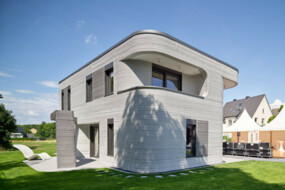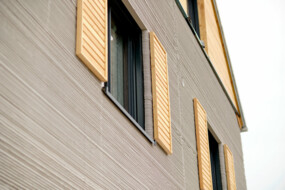Brick by brick at the touch of a button
3D printing has given the building industry new ideas. The project is still in its infancy, but it might not be long before automated building alleviates the problem of the lack of skilled workers. We are also seeing advances in industrial prefabrication as another facet of automated construction.
Brick by brick. All by hand and with a lot of hard work. How long must such work be carried out, and by whom? One of the greatest challenges facing the building industry, the shortage of skilled labour, might soon be solved.
Dr. Carsten Zilg, head of R&D at Sievert, is convinced that, in future, some of the value creation will be taken over by methods that save human muscle power and at the same time compensate for the lack of skilled workers: “We are following the trend towards automated building very attentively in order to assess the pros and cons compared with conventional methods of construction. That will enable us to offer a modern range of products tailored to users’ needs.” Sievert SE has already responded to these changes through various projects. Industrial prefabrication, e.g. masonry leaves that are factory-prefabricated using automated methods and erected on site as complete elements, is an important part of automated building. Mortar for 3D printing with a robotic concreting machine has also already been developed in collaboration with the Messerschmidt company. Any building elements can thus be produced with 3D printing. Some techniques in automated building are already being used by customers.
3D printing vs industrial prefabrication
Compared with industrial prefabrication, 3D printing still suffers from a few technical uncertainties: “Experience of this method is still lacking. But how do we get this experience?” is the question that not only Dr. Zilg is asking when it comes to this aspect of automated construction. Architects do not yet have any standardised software for designing buildings that can be produced using 3D printing. The reason for this is that the building materials to be printed are not yet fully developed and have to be customised to suit each type of printer. People must live and work safely in buildings built using 3D printing. To achieve that, we need a sound set of rules consisting of legislation and execution stipulations, which does not yet exist. Summing up: According to Dr. Zilg, it could take up to 10 years before 3D printing becomes an established part of everyday construction.

“In conventional construction, the possibilities for using formwork are limited. Voids or amorphous shapes are very costly to produce. But using 3D printing, formwork with any shape, any dimensions can be produced faster and more easily, thus saving up to 30% of the costs of building the structural carcass.”
Dr. Carsten Zilg, head of R&D at Sievert
3D printing as innovator for the future
The potential here is immense. Customers get a number of advantages with 3D printing. “In conventional construction, the possibilities for using formwork are limited. Voids or amorphous shapes are very costly to produce. But using 3D printing, formwork with any shape, any dimensions can be produced faster and more easily, thus saving up to 30% of the costs of building the structural carcass,” says Dr. Zilg. He reckons that the 3D powder bed fusion method will even be able to create hollow elements that can carry the same loads as a solid element built using conventional methods. That would lead to further savings in materials and hence to fewer materials-related carbon emissions.
Professional mortars are crucial for automated building
As one of the largest premixed dry mortar manufacturers in Europe, Sievert SE certainly has sufficient experience to produce suitable mortars for both industrial prefabrication and 3D printing. Robots can stack bricks faster than humans, for example, and so the mortar must cure faster. According to Dr. Zilg, this is beneficial for customers: “The fastest possible progress on site is always essential for keeping the cost per square metre as low as possible.” This is also important for the prefabricated masonry leaf, where a computer-controlled machine can place bricks or blocks faster than humans.








